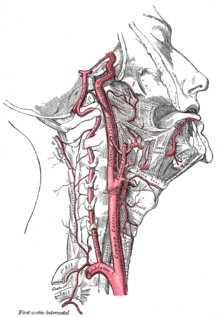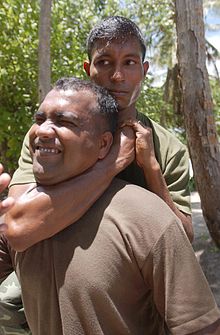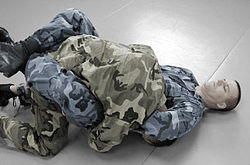- Choke-out
-
The use of chokeholds has become quite prevalent, in competitions such as Brazilian Jujitsu, Competition Sambo, Submission Wrestling, Mixed Martial Arts, it also has Law enforcement and military applications. A Choke-Out is when one person uses force and leverage (a chokehold) in order to subdue an opponent, and thereby making said opponent lose consciousness. A Choke-out should not be confused with erotic asphyxiation, the fainting game; in these cases the person that loses consciousness intentionally loses consciousness for the stimulation their body receives. A choke-out should also not be confused with any medical conditions causing fainting to happen without the application of a chokehold.
Contents
What Happens During a Choke?
Though there are different variables involved in a chokehold, and many different kinds of chokeholds but they all boil down to just two different categories, the blood choke and the air choke. As these names imply a blood choke disrupts blood circulation to the brain while an air choke disrupts breathing. Air chokes are commonly used in competition but usually do not result in a choke-out, they are very painful and cause “air hunger.” During a blood choke blood circulation to the brain is disrupted or cut off. Disrupting the blood flow in is accomplished by compressing one or both of the carotid arteries and or the jugular veins usually with little to no pressure put on the actual airway. The logistics behind the loss of consciousness, in other words what is happening when someone loses consciousness is somewhat confusing. As pressure is placed on the carotid artery there is also pressure being placed on the baroreceptors (which are little receptors inside of the carotid artery). These receptors send signals into the brain, causing vasodilation. The dilation causes blood vessels in the brain to get larger. The widened blood vessels do not allow blood to properly profuse the brain leading to loss of consciousness. The vasodilation is analogous to taking a garden hose and replacing it with a fire hose but keeping the same pressure. Instead of having a steady flow with adequate pressure, water just dribbles out the fire house. The same is true for the arteries, instead of having a steady flow of oxygenated blood; it only trickles through because of the expanded size of the arteries. The pressure put on the carotid artery and the subsequent signals sent, causes the victim’s blood pressure to drop dramatically, below what is needed in order to remain conscious. It is not from the actual cutting off of blood to the brain that causes someone to lose consciousness but rather, from the drop in blood pressure, the body shuts itself down. Many sources use the term cerebral hypoxia to describe the state of oxygen flow while being choked-out, commonly this term refers to lack of oxygen in the brain. More accurately this term means lack of oxygen to the outer regions of this brain, and specifically with blood flow unimpaired[1](usually caused by chemical poisoning in the blood such as carbon monoxide poisoning). The more accurate less used medical term is cerebral anoxia-“a condition in which brain tissue is deficient in oxygen. This state is caused by circulation failure.”
Dangers of the Choke-Out
There is a lot of debate over the dangers of a choke out on a person. One thing that everyone agrees on is this; after 4–6 minutes of sustained cerebral anoxia permanent brain damage, the death of brain cells, will begin to occur.[2] Now for the debatable; whether or not a Choke-Out in a controlled manner with blood flow obstructed for far less than 4 minutes is dangerous. One medical argument is this; that when pressure is applied to the carotid artery not only do the baroreceptors send a signal to the brain but they also send a signal to the pacemaker of the heart via the Vagus nerve. This signal tells the heart to reduce volume of blood per heartbeat, typically up to one third. But there is a very slight chance of having the rate and force drop to zero “flat line” also known as asystole.[3] The opposite side of this argument comes from Judo. With Thousands of tournaments since the sport started in 1882, hundreds of thousands of chokes and the probability of hundreds if not thousands of choke-outs in that time with no reported deaths due to Chokes the chances of asystole happening are slim.[4] In essence though theoretically it might be a possibility for asystole to occur it is an improbability. As the sports of MMA, Judo, submission wrestling and Brazilian jujitsu continue to become more popular time will tell whether or not it is dangerous to be choked out. Until then it is up to everyone involved in these sports to make the decision to be safe while training in order to avoid sustained cerebral anoxia which can cause permanent brain tissue damage if the brain is deprived of oxygen for longer than 4 to 6 minutes.
Effects of a Choke-Out
In 2004 there was an article published in the Journal of American Neurological association entitled “Syncope: A videometric analysis of 56 episodes of transient cerebral hypoxia” Even though in this case cerebral hypoxia was studied instead of cerebral anoxia full unconsciousness was reached and since the two phenomena are so similar the effects of one will be similar to the other. In the 42 subjects that completely lost consciousness their syncope state lasted 12.1 seconds plus or minus 4.4 seconds. Muscle jerks occurred in 90% of patients. The most common pattern of movement consisted of multifocal arrhythmic jerks (uncoordinated spasms of multiple muscle groups moving at the same time) in both proximal and distal muscles. Additional movements also occurred such as: righting movements (if the patient had slumped one way while falling asleep they woke up and immediately corrected, if not overcorrected), oral automatisms, and head turns. In most of the patients their eyes remained open. And sixty percent of the patients reported having visual and auditory hallucinations.[5]
Different people feel different things while they are being choked. The sensations are often difficult to describe. Some common sensations as reported by Brazilian jujitsu practitioners include but are not limited to: a feeling that the victim’s surroundings are expanding and contracting around them. A sensation similar to tunnel vision, working in from the edges of the victim’s vision goes blank. It is different from tunnel vision in that the victim is not focusing on one thing and losing vision of all else the victim is just losing vision. Without intervention the victim’s vision will completely go dark followed by unconsciousness. Pressure is extremely common. Pressure is usually felt in the neck and head area in particular the eyes. People often feel pressure pushing from the inside out on their eyes and burst blood vessels can occur. Pressure on the neck is the opposite the pressure is felt pushing from the outside in. One Very predictable sensation is an intense feeling of light headedness. This is for the same reason that you feel light headed when you go from a laying position to a standing position you do not have enough fresh oxygenated blood reaching your brain. Lastly in a competition setting with the adrenaline going many people claim to have felt nothing at all as they were being choked, they had no idea until it was too late that they had been put into a chokehold. They only find out after they are woken up and asked if they are alright.[6]
The sensations do not stop when the victim loses consciousness. Most people report having dreams that feel like they have lasted for long amounts of time, minutes to hours even though they have been in the syncope state for mere seconds. Through their dreams people report to keep the feeling of light headedness, and when they wake up everything seems a little unreal for a few seconds. Often people’s dreams/hallucinations are tied into sounds around them, even more so than regular sleep. For example if there is the sound of a telephone ringing in the room the unconscious person’s dream could be based almost entirely around a phone. Often the sensation of light and tingly stays with the victim for minutes after the victim wakes up. Much of the time the victim can function enough to drive a car, or do any regular task within a few hours of waking up but will probably be disoriented for at least a few minutes.[6]
Common Types of Chokes
Some common chokes include: rear naked choke, arm triangle, triangle, and the guillotine. These chokes are all commonly used but by far the rear naked choke is the most popular. The rear naked choke is applied from behind. There are two ways of applying the rear naked choke. The first step is the same for both of the rear naked variations, slide one hand around the neck of the victim so that the front of their neck is in the crook of the aggressor’s elbow and the sides of their neck are touching the aggressor’s biceps and wrist respectively. Here is where the variation takes place. In the “figure four” way of chocking the aggressor uses the hand of the arm that is encircled around the victims throat and grabs onto their own biceps. After gripping their own biceps the aggressor will securely place their other hand behind the victims head and then squeeze everything together arching his back and squeezing, this variation works much faster than the second variation. In the other variation instead of grabbing their biceps the aggressor will lock his hands. From here he will pull back with his arms. This variation provides less control of the head and more control of the neck, it is almost a hybrid of a blood choke and an air choke; this variation causes more pain for the victim but also takes longer to produce a choke-out. Though a choke-out can occur quickly it is generally accepted that the figure four method works more efficiently. In either case the choke works because pressure is placed on the sides of the neck. In the figure four method as everything is squeezed together the aggressor’s arms naturally cut off circulation. In the clasped hands method there may need to be some adjusting of angles before the pressure is correct, but in both cases the pressure needs to be on the sides of the neck to cause a choke-out.
The Guillotine is another extremely common choke. This choke is interesting because it is similar to the clasped hands method of rear naked chokes in that it can be both. The guillotine is from the front of a victim. Usually with the victims head to either side of the aggressor, the aggressor will lock their hands around the neck of the victim so that it looks similar to a guillotine that one might think of from the French revolution. Then the aggressor arches their back. If the victim remains looking forward they will have pressure put directly on their trachea, and the choke will be an air choke. But if the victim turns to a side or the aggressor is able to arch at an angle instead of straight up it can be a blood choke. One of the fighters on The Ultimate Fighter named Cody Mackenzie chocked out several fighters in such dramatic fashion that many call his twist on the guillotine a “Mackenzie-tine.” His personal twist on the classic guillotine has brought it back into play as a choke-out choke as he was able to choke his opponents in mere seconds. The key here is that one or both sides are put under pressure in order to cause the choke-out. The pressure on the sides comes from the arms of the aggressor.
The Triangle choke is also extremely common. This is most commonly applied from on bottom in guard (a position in which the bottom person has their legs around the person on top). The aggressor will usually isolate one of the victims arms and push it down and in towards the belly button of the victim. Next the aggressor will throw their leg up and over the shoulder of the isolated arm, and will hook the neck and other shoulder of the victim. Then with their free leg will throw up and over hooking their own foot in the crook of their own knee. At this point the victim should have 1 arm in and 1 arm out. From here the aggressor will need to pull down on the head, push the inside arm off to one side and squeeze their legs. This Choke is very odd, not only somewhat odd looking but odd in how the choke works. Instead of the pressure on the sides of the neck being caused by the arms of the aggressor it is actually caused by the inside shoulder of the victim. As the aggressor pulls the head down and keeps everything enclosed by their legs the victims inside shoulder is pressed toward their neck, cutting of blood circulation. A person put in a triangle is literally choked-out by their own shoulder.
The arm triangle has the same basic principle of choking someone out using their own shoulder but is just different in practice. Instead of trapping one shoulder against a person’s neck with their legs this time the aggressor will use their arms. There are many variations of the arm triangle including: D’arce and anaconda. The basic principle is that the victim has one arm and their neck held together by the aggressor’s arms. It usually takes place from the victim’s front.
Conclusion
Though some point to the possibility of a person being choked out as dangerous, it would appear from it being a common occurrence with no reported cases of fatality that it is safe. That being said it is definitely dangerous for someone to remain in a chokehold after losing consciousness. It is highly recommended that anyone interested in any kind of grappling or in any way interested in practicing these chokes should consult a professional. Practice hard, practice smart, and practice in a safe controlled environment.
References
- ^ “DiseaseandconditionsCerebralHypoxia,”ClevelandClinic,Accessed4/19/11http://my.clevelandclinic.org.disorders/cerebral_hypoxia/hic_cerebral_hypoxia.aspx
- ^ “CerebralHypoxia,”Medlineplus,Accessed4/19/11,http://www.nlm.nih.gov/medlineplus/ency/article/001435.htm
- ^ “Breathplay,”Accessed1/31/11 http://www.epedominion.com/HealthSafty/breath.htm
- ^ “DeathsAllegedlyCausedbyChokeholds,”ByE.K.KoiwaiMD,Accessed4/19/11 http://judoinfo.com/chokes5.html
- ^ “Syncope:Avideometricanalysisof56episodesoftransientcerebralhypoxia,”JournalofAmericanNeurologicalsociety,Accessed4/19/11,http://onlinelibrary.wiley.com/doi/10.1002/ana.410360217/abstract
- ^ a b Daazndoodcommentongotchockedoutforfirsttimetoday.11-15-2010,http://forum.bodbuilding.com/archive/index.php/t-129159311.html
Categories:- Chokeholds
- Martial art techniques
Wikimedia Foundation. 2010.



